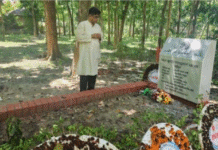Number of Aedes mosquitoes increased by 13 times in city
 The number of Aedes mosquitoes that transmit the deadly dengue virus has increased by 13 folds in Dhaka’s two city corporations, leaving people in danger.
The number of Aedes mosquitoes that transmit the deadly dengue virus has increased by 13 folds in Dhaka’s two city corporations, leaving people in danger.
A study by the Directorate General of Health Services (DGHS) says the density of matured Aedes vector population was 36 before the rain which has increased to 487. The pre-rain study was commissioned between 3 March and 12 March while the last study was conducted between 17 and 27 July in 100 places of the 98 wards of the Dhaka North City Corporations and Dhaka South City Corporation.
The study also shows the density of larvae has also been intensified during that period, meaning the number of mosquitoes will surge further.
The researchers found that the mosquito larvae were mainly found in water inside abandoned tires, plastic drums, buckets, open tanks and flowerpots.
The DGHS’s communicable disease wing says the dengue patients are on the rise as the adult Aedes mosquitoes and its larvae have increased by many times.
The officials at DGHS also said the prevention of the Aedes depends on the intensity of preventive activities, awareness of the public and availability of mosquito repellents.
 Bangladesh is not alone struggling against the outbreak of dengue. According to the European Centre for Disease Prevention and Control, the dengue situation has worsened in Nepal, Sri Lanka, Maldives, Malaysia, Thailand, Cambodia, Pakistan, Laos, Singapore, as well as in Vietnam.
Bangladesh is not alone struggling against the outbreak of dengue. According to the European Centre for Disease Prevention and Control, the dengue situation has worsened in Nepal, Sri Lanka, Maldives, Malaysia, Thailand, Cambodia, Pakistan, Laos, Singapore, as well as in Vietnam.
Prothom Alo investigation finds so far 85 people have died of dengue fever this year.
As many as 15,650 people have already been admitted to hospitals with dengue fever before July, breaking the record of the last year. In 2018, 10,148 were infected with the virus.









